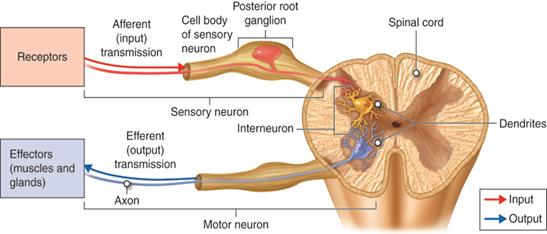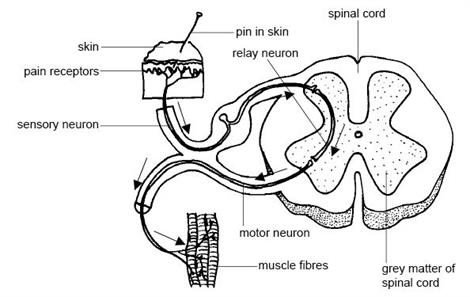
PUMPA - SMART LEARNING
எங்கள் ஆசிரியர்களுடன் 1-ஆன்-1 ஆலோசனை நேரத்தைப் பெறுங்கள். டாப்பர் ஆவதற்கு நாங்கள் பயிற்சி அளிப்போம்
Book Free DemoThe functional classification of neurons is based on the direction in which the signal travels with respect to the CNS. The neurons in the human nervous system are categorised into three groups based on their functions:
- Sensory neurons
- Motor neurons
- Association neurons

The action of sensory and motor neuron
1. Sensory neurons/Afferent neurons - These neurons transmit nerve impulses by connecting sensory or receptor cells or organs to the central nervous system. Dendrite terminals become modified to form receptors.
2. Motor/efferent neurons - They transmit impulses from the central nervous system to effectors such as muscles and glands. A neuromuscular junction is formed when the axon terminals meet the motor endplate.
3. Relaying or Association neurons - They occur between the sensory and motor neurons in the brain and spinal cord for the distant transmission of nerve impulses.

Relay neurons
Transmission of the nerve impulse:
The synapse, often known as a "gap," is the point at which information is passed from one neuron to the next. Synapses are formed when the axon of one neuron connects to the dendrite spine of another. A synapse is formed by the membranes of a presynaptic and postsynaptic neuron that may or may not be split by a synaptic cleft.
Transmission of signals through synapsis
The nerve impulse is transmitted in the form of the electrochemical wave from one neuron to another through junctions called synapsis.
Note: The neuron that transmits the signal is the presynaptic neuron, while the neuron that receives it is postsynaptic neuron.
The flow of nerve impulses from the axonal end of one neuron to the dendrite of another neuron through a synapse is called synaptic transmission.
Pathway of nerve impulses from receptor to brain:
Information about the change in environment is detected by a receptor and is transmitted as an electrical impulse by the dendritic tips of a neuron.
\huge{\downarrow}
This electrical impulse travels from the dendrite to the cell body and at the axon terminals.
\huge{\downarrow}
The electrical impulse at the axon's end triggers the release of chemicals (neurotransmitters).
\huge{\downarrow}
These chemicals cross the synapse and initiate a similar electrical impulse in the following neuron's dendrite.
\huge{\downarrow}
Then this electrical impulse travels from the dendrite again to the cell body and to be transmitted along the axon.
Pathway of nerve impulses from the brain to effector:
The information received via receptor is processed in the brain or spinal cord, and the response is transmitted as an electrical impulse.
\huge{\downarrow}
This electrical impulse travels from the dendrite to the cell body and at the axon terminals.
\huge{\downarrow}
The electrical impulse at the axon's end triggers the release of chemicals.
\huge{\downarrow}
These chemicals cross the synapse and initiate a similar electrical impulse in the following neuron's dendrite.
\huge{\downarrow}
Finally, a similar synapse permits such impulses from neurons to other cells like glands and muscle cells.
Reference:
https://breakingmuscle.com/fitness/the-neurological-benefits-of-clean-and-snatch-complexes
http://hiscience.pbworks.com/w/page/123385353/1%20BACH%20FEBRERO%202018